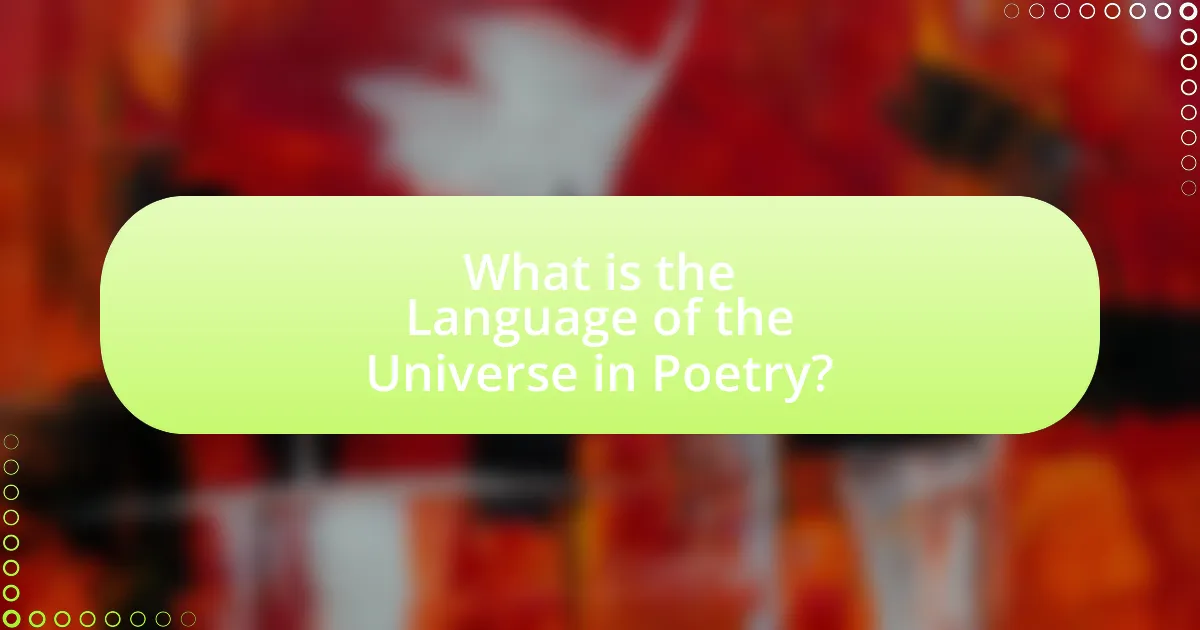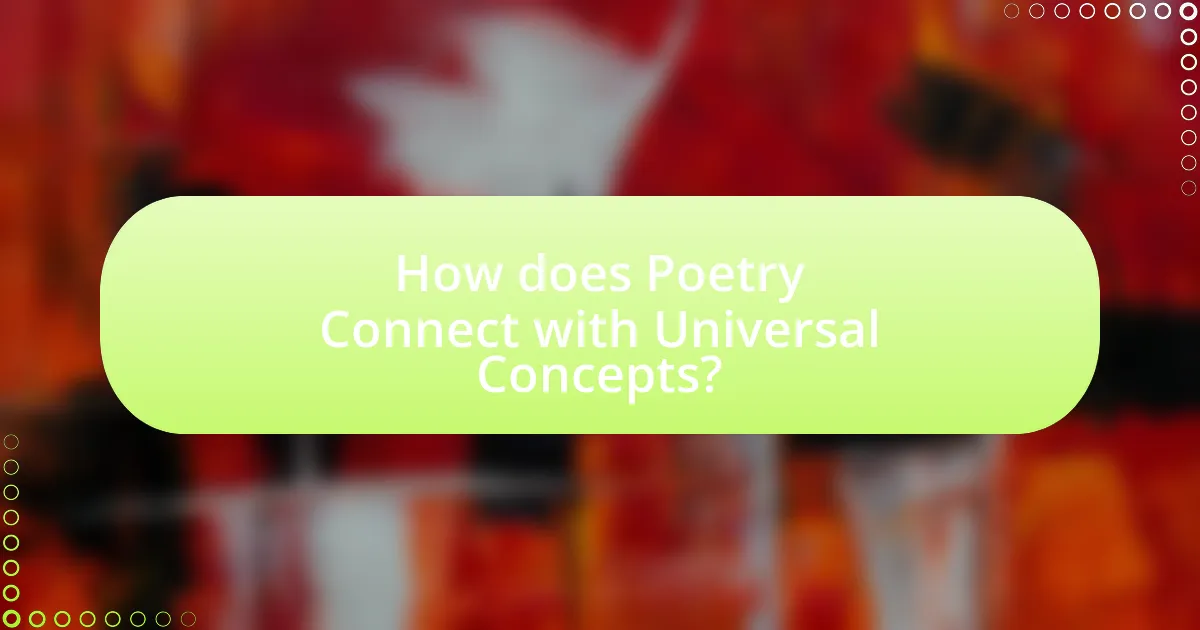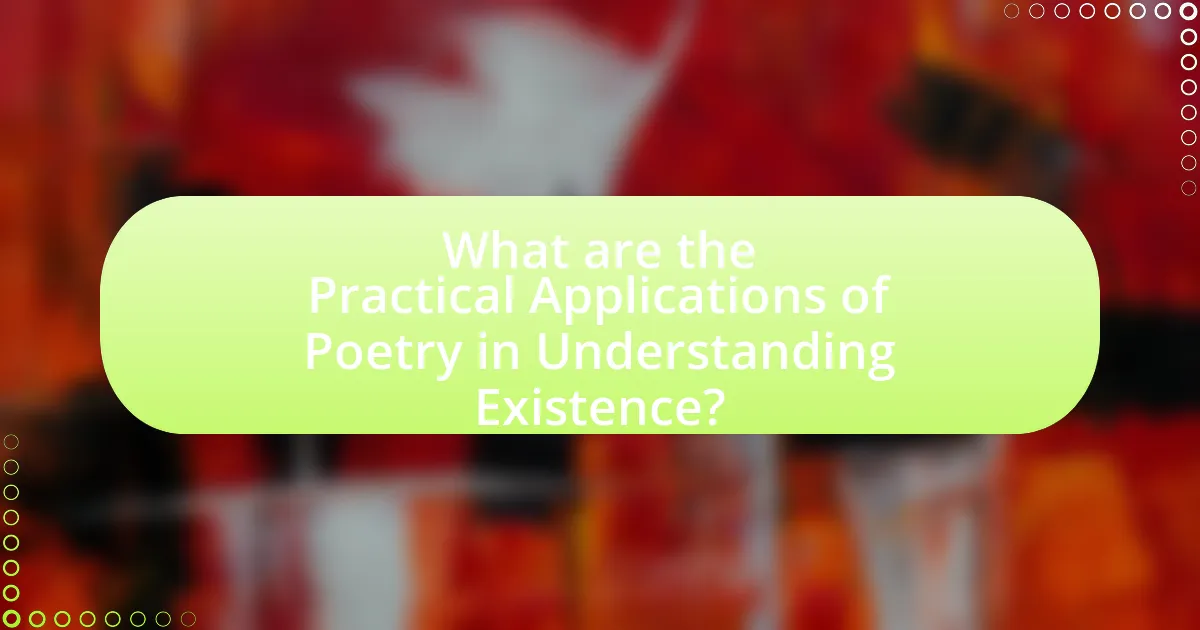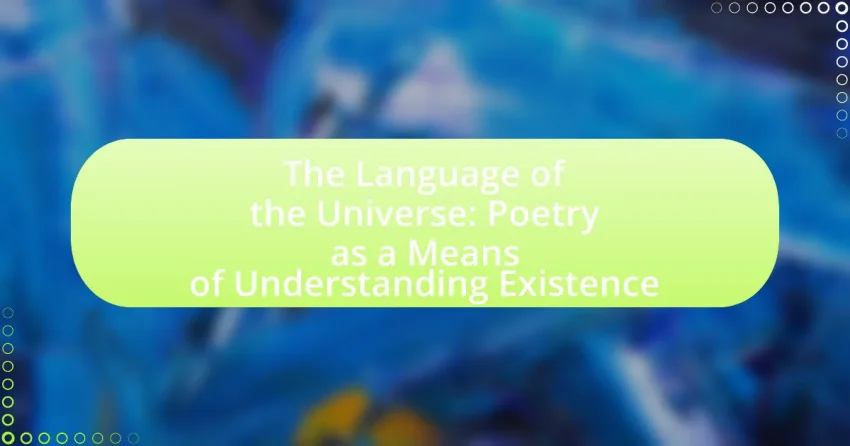The article explores “The Language of the Universe: Poetry as a Means of Understanding Existence,” emphasizing how poetry utilizes universal themes, symbols, and emotions to convey profound truths about life and the cosmos. It examines the role of poetry in facilitating emotional connections and self-reflection, highlighting key elements such as imagery, rhythm, and metaphor that contribute to its universal appeal. The discussion includes how poetry addresses existential themes, the emotional responses it evokes, and its capacity to bridge cultural divides, ultimately positioning poetry as a powerful medium for exploring and understanding the complexities of human existence.

What is the Language of the Universe in Poetry?
The Language of the Universe in Poetry refers to the use of universal themes, symbols, and emotions that transcend cultural and linguistic barriers to convey profound truths about existence. Poetry often employs metaphors, imagery, and rhythm to express complex ideas about life, nature, and the cosmos, allowing readers to connect with these concepts on an emotional and intellectual level. For example, poets like Rainer Maria Rilke and Pablo Neruda have explored existential themes that resonate universally, illustrating how poetry can serve as a bridge to understanding the human experience and the universe itself.
How does poetry serve as a medium for understanding existence?
Poetry serves as a medium for understanding existence by encapsulating complex human emotions and experiences in a structured form, allowing readers to explore and reflect on their own lives. Through the use of metaphor, imagery, and rhythm, poetry distills profound truths about the human condition, facilitating a deeper connection to existential themes such as love, loss, and identity. For instance, the works of poets like Rainer Maria Rilke and Emily Dickinson often delve into the nature of existence, prompting readers to confront their own mortality and the search for meaning. This reflective process is supported by studies in literary theory, which suggest that engaging with poetry can enhance emotional intelligence and self-awareness, thereby enriching one’s understanding of existence.
What elements of poetry contribute to its universal language?
Imagery, rhythm, and emotion are key elements of poetry that contribute to its universal language. Imagery allows readers to visualize experiences and emotions, transcending cultural and linguistic barriers. Rhythm creates a musical quality that resonates with human experiences, making the poem accessible regardless of language. Emotion evokes shared feelings, fostering a connection among diverse audiences. These elements collectively enable poetry to communicate profound truths and experiences that resonate across different cultures and languages, reinforcing its status as a universal form of expression.
How do metaphors in poetry reflect existential themes?
Metaphors in poetry reflect existential themes by encapsulating complex human experiences and emotions, illustrating the search for meaning in life. For instance, poets often use metaphors to compare life to a journey, highlighting the uncertainty and struggles inherent in existence. This technique allows readers to engage with profound philosophical questions about identity, purpose, and mortality. A notable example is T.S. Eliot’s use of the metaphor of a “wasteland” in his poem, which symbolizes disillusionment and the search for meaning in a fragmented world. Such metaphors serve as a bridge between abstract existential concepts and tangible human experiences, making the exploration of existence more relatable and impactful.
Why is poetry considered a profound means of expression?
Poetry is considered a profound means of expression because it encapsulates complex emotions and ideas in a condensed form, allowing for deep personal and universal connections. The use of metaphor, rhythm, and imagery in poetry enables writers to convey feelings and thoughts that may be difficult to articulate in straightforward language. For instance, studies have shown that poetry can evoke emotional responses more effectively than prose, as evidenced by research published in the journal “Psychological Science,” which found that readers often experience heightened emotional engagement with poetic texts. This capacity to resonate on multiple levels—intellectually, emotionally, and aesthetically—demonstrates poetry’s unique ability to articulate the nuances of human experience, making it a powerful tool for understanding existence.
What emotional responses does poetry evoke in relation to existence?
Poetry evokes a range of emotional responses related to existence, including introspection, existential contemplation, and a sense of connection to the human experience. These emotional responses arise from poetry’s ability to articulate complex feelings and thoughts about life, death, and the nature of being. For instance, poets like John Keats and Emily Dickinson explore themes of mortality and the fleeting nature of existence, prompting readers to reflect on their own lives and the universal human condition. Research indicates that engaging with poetry can enhance emotional intelligence and empathy, as it allows individuals to process their emotions and connect with others’ experiences. This connection reinforces the idea that poetry serves as a powerful medium for exploring and understanding the intricacies of existence.
How does the structure of poetry enhance its meaning?
The structure of poetry enhances its meaning by organizing language in a way that emphasizes rhythm, sound, and visual layout, which can evoke emotions and create deeper connections to the themes presented. For instance, the use of enjambment can create a sense of urgency or continuity, while a fixed rhyme scheme can provide a musical quality that reinforces the poem’s emotional tone. Additionally, the arrangement of stanzas can guide the reader’s interpretation, as seen in works like T.S. Eliot’s “The Waste Land,” where the fragmented structure mirrors the disjointed nature of modern existence, thereby deepening the thematic exploration of alienation.

How does Poetry Connect with Universal Concepts?
Poetry connects with universal concepts by encapsulating shared human experiences and emotions, allowing readers to explore themes such as love, loss, and identity. This connection is evident in the way poetry transcends cultural and temporal boundaries, resonating with diverse audiences. For instance, the works of poets like Rumi and Maya Angelou address fundamental aspects of the human condition, illustrating how poetry can articulate universal truths. Research indicates that poetry’s use of metaphor and imagery fosters empathy, enabling individuals to relate to experiences outside their own, thus reinforcing its role as a bridge to universal concepts.
What themes in poetry resonate with the human experience?
Themes in poetry that resonate with the human experience include love, loss, identity, nature, and the passage of time. Love is a universal emotion explored in countless poems, reflecting its significance in human relationships and connections. Loss captures the profound grief and longing that accompany the death of loved ones or the end of relationships, making it a relatable theme for many. Identity addresses the quest for self-understanding and belonging, often highlighting cultural, social, and personal dimensions. Nature serves as a backdrop for human emotions and experiences, symbolizing beauty, transience, and the interconnectedness of life. The passage of time reflects the inevitability of change and mortality, prompting introspection about life’s fleeting moments. These themes are prevalent across various cultures and historical periods, demonstrating their enduring relevance to the human condition.
How do poets explore concepts like time and space?
Poets explore concepts like time and space through imagery, metaphor, and structure, allowing them to convey complex experiences and emotions. For instance, poets often use metaphors to juxtapose fleeting moments with the vastness of the universe, as seen in works like T.S. Eliot’s “The Love Song of J. Alfred Prufrock,” where time is depicted as both a linear progression and a cyclical experience. Additionally, the use of enjambment and varied stanza lengths can create a sense of movement through time and space, as demonstrated in Walt Whitman’s “Song of Myself,” which captures the interconnectedness of individual experiences within the broader cosmos. These techniques enable poets to articulate the abstract nature of time and space, making them tangible and relatable to readers.
What role does nature play in the poetry of existence?
Nature serves as a fundamental source of inspiration and metaphor in the poetry of existence, reflecting the interconnectedness of life and the human experience. Poets often utilize natural imagery to explore themes of beauty, transience, and the cyclical nature of life, which resonate deeply with existential inquiries. For instance, the works of poets like William Wordsworth and John Keats illustrate how nature embodies emotional states and philosophical reflections, reinforcing the idea that human existence is intricately linked to the natural world. This connection is supported by studies in ecopoetics, which emphasize how nature shapes human perception and understanding of existence, highlighting the role of environmental context in shaping poetic expression.
How can poetry bridge cultural and philosophical divides?
Poetry can bridge cultural and philosophical divides by expressing universal emotions and experiences that resonate across different backgrounds. Through its use of metaphor, imagery, and rhythm, poetry transcends linguistic barriers and allows individuals to connect on a deeper emotional level. For instance, the works of poets like Pablo Neruda and Rumi illustrate how themes of love, loss, and longing are shared human experiences, regardless of cultural context. This shared emotional landscape fosters empathy and understanding, enabling readers from diverse backgrounds to find common ground. Additionally, poetry often invites interpretation, encouraging dialogue about differing perspectives and beliefs, which can lead to greater cultural appreciation and philosophical discourse.
What examples illustrate poetry’s role in cross-cultural understanding?
Poetry serves as a vital medium for cross-cultural understanding through its ability to convey universal themes and emotions. For instance, the works of Pablo Neruda, a Chilean poet, resonate globally due to their exploration of love, loss, and social justice, bridging cultural divides. Similarly, the poetry of Rumi, a 13th-century Persian poet, transcends cultural boundaries by expressing spiritual themes that appeal to diverse audiences, fostering empathy and connection. Furthermore, the anthology “The Poetry of World War I” showcases poems from various cultures, highlighting shared human experiences during conflict, thereby promoting understanding among different nationalities. These examples demonstrate how poetry can articulate shared human experiences, facilitating dialogue and connection across cultures.
How do different cultures interpret existential themes in poetry?
Different cultures interpret existential themes in poetry through their unique philosophical, spiritual, and historical lenses. For instance, Western poetry often emphasizes individualism and personal struggle, as seen in the works of existentialist poets like T.S. Eliot, who grappled with themes of alienation and meaninglessness in a modern context. In contrast, Eastern poetry, such as that from the Zen Buddhist tradition, frequently reflects on the interconnectedness of existence and the transient nature of life, as exemplified in the haikus of Matsuo Bashō, which capture moments of beauty and impermanence. Additionally, African poetry often incorporates communal experiences and ancestral connections, highlighting the collective nature of existence, as seen in the works of poets like Leopold Sedar Senghor, who emphasizes the relationship between identity and community. These varying interpretations illustrate how cultural backgrounds shape the understanding of existential themes in poetry, revealing diverse perspectives on existence itself.

What are the Practical Applications of Poetry in Understanding Existence?
Poetry serves as a practical application in understanding existence by encapsulating complex human emotions and experiences in a structured form, allowing individuals to explore and reflect on their own lives and the world around them. Through the use of metaphor, imagery, and rhythm, poetry distills profound truths about existence, facilitating deeper connections to universal themes such as love, loss, and identity. For instance, the works of poets like Rainer Maria Rilke and Mary Oliver often address existential questions, prompting readers to contemplate their place in the universe. This engagement with poetic language can enhance emotional intelligence and foster empathy, as evidenced by studies showing that reading poetry can improve one’s ability to understand others’ feelings and perspectives.
How can individuals use poetry for personal reflection?
Individuals can use poetry for personal reflection by engaging with the themes and emotions expressed in the poems, allowing them to explore their own thoughts and feelings. This engagement can lead to deeper self-awareness and understanding, as poetry often encapsulates complex human experiences and emotions. Research indicates that reflective writing, including poetry, can enhance emotional intelligence and promote mental well-being, as it encourages individuals to articulate their inner experiences and confront their feelings. For example, a study published in the Journal of Poetry Therapy found that participants who wrote poetry reported increased self-reflection and emotional processing, demonstrating the effectiveness of poetry as a tool for personal insight.
What techniques can enhance the experience of reading poetry?
Techniques that can enhance the experience of reading poetry include reading aloud, engaging with the poem’s structure, and exploring the historical and cultural context of the work. Reading poetry aloud allows the reader to appreciate the rhythm, sound, and emotional nuances that are often lost in silent reading. Engaging with the poem’s structure, such as its meter and form, helps to uncover deeper meanings and enhances the overall understanding of the text. Additionally, exploring the historical and cultural context provides insight into the poet’s intentions and the themes addressed, enriching the reader’s experience. These techniques are supported by studies in literary analysis, which emphasize the importance of auditory and contextual engagement in understanding poetry.
How can writing poetry aid in processing existential thoughts?
Writing poetry aids in processing existential thoughts by providing a structured outlet for complex emotions and ideas. This creative expression allows individuals to articulate their feelings about existence, identity, and the human condition, facilitating deeper self-reflection. Research indicates that engaging in creative writing, including poetry, can enhance emotional regulation and cognitive processing, as evidenced by studies showing that expressive writing reduces anxiety and promotes psychological well-being. By transforming abstract existential concerns into tangible words, poetry enables individuals to confront and explore their thoughts, leading to greater clarity and understanding of their place in the universe.
What are some recommended practices for engaging with poetry?
To engage with poetry effectively, readers should read aloud to appreciate the rhythm and sound, annotate texts to capture personal interpretations, and explore various forms and styles to broaden understanding. Reading aloud enhances the auditory experience, allowing listeners to grasp nuances in tone and emotion. Annotating encourages deeper analysis, fostering connections between personal experiences and the poem’s themes. Exploring diverse forms, such as sonnets, free verse, and haikus, exposes readers to different poetic techniques and cultural perspectives, enriching their overall appreciation of poetry.
How can one create a personal poetry reading list?
To create a personal poetry reading list, one should begin by identifying specific themes or styles of poetry that resonate with their interests. This can include exploring various poets, eras, or movements, such as Romanticism or Modernism. After determining these preferences, individuals can curate a selection of poems or collections that align with their chosen themes. For instance, if someone is interested in nature poetry, they might include works by poets like William Wordsworth or Mary Oliver. Additionally, utilizing resources such as poetry anthologies, online platforms, or literary recommendations can enhance the list. This methodical approach ensures a personalized and meaningful reading experience, allowing for deeper engagement with the art of poetry.
What strategies can help in analyzing poetic works for deeper understanding?
To analyze poetic works for deeper understanding, one effective strategy is to examine the poem’s structure, including its form, meter, and rhyme scheme. This analysis reveals how these elements contribute to the poem’s overall meaning and emotional impact. For instance, a sonnet’s strict structure can enhance themes of love or time, while free verse may reflect chaos or freedom. Additionally, exploring figurative language, such as metaphors and similes, allows readers to uncover layers of meaning that may not be immediately apparent. Historical context and the poet’s background also provide valuable insights, as they can influence the themes and emotions expressed in the work. By combining these strategies, readers can achieve a more nuanced interpretation of poetic texts.
